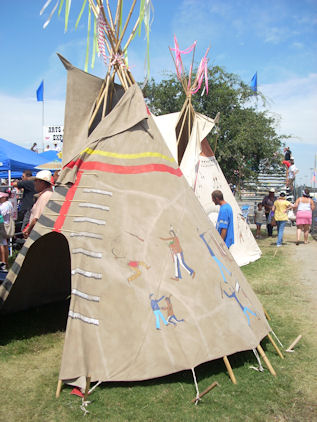Welcome back, Gentle Reader! Last entry, I introduced you to the 46th Annual Nation Championship Indian Pow Wow, which was so splendiferous that I actually visited it on two consecutive days (September 6-7). Now, an event this big isn’t something you can easily review in a single entry, and so I didn’t even try. In fact, it’s gonna take three.
Previously, I mostly described the commercial aspects of the event. While many of the vendor booths were focused on the traditional touristy type of items, they tended to be of high quality, and here and there I occasionally found something that especially struck my fancy: katchinas, genuine well-made spear points, coyote teeth, turquoise, fur shields, and more. But I didn’t get to talk about everything I wanted to before, so I’m going to go on for a bit more here, before I move on to what the event was really about: the dancing.
Now, I know this next thing is a little cliché, but it struck me as interesting. Wooden Indians are kind of rare today, but they’re still not that big a deal — a lot of them survive as curiosities here and there, whether in rustic-style restaurants or flea markets. But this fellow is different.

What I mean is, this is no Kawliga. Most wooden Indians are depicted as being from the Plains tribes, wearing huge feathery war bonnets and carrying a big bundle of cigars or something, because they were cigar store Indians, after all. You might say, “So what? We got tobacco from the Indians, yo.” Well, that’s true, but we didn’t get it from the Plains Indians — they were generally nomads who chased after game, collected existing wild plants, but didn’t use agriculture. (Yes, nitpickers, I know that this is a generalization, not strictly accurate everywhere; but bear with me). As I recall, tobacco was grown by eastern tribes. So those wooden Indians are typically inaccurate. Well, not only does this guy not come bearing tobacco, he looks like he’s probably either Mohawk or Pawnee, probably the latter, and he’s NOT wearing the war bonnet, which was restricted to just a few tribes anyway. His face paint and outfit also look appropriate. So, while I’m not the world’s expert on the subject, he’s more accurate than most wooden Indians — and he’s different, anyway. I thought he looked cool.
Moving right along, I was rather taken by this happy lady’s beadwork. Check out that rifle sheath, eh? I can’t tell you exactly who she is because, like a doofus, I lost her card. But I know that her name is Anna, and she’s Apache.

Later on, after one of the dances, we retreated to the Expo to get out of the sun, and I noticed this artist working on a new piece. I don’t think he noticed I was there. I really like his hat.

Finally, I couldn’t pass up the chance to show you the booth selling Indian soul food.

I didn’t get any because it was kind of pricy, but I’ve had fried bread before, and it’s very good; kind of like an unsugared funnel cake. I don’t know about the tacos, but frankly, I happen to know that just about anything used in Mexican food — from tamales to tortillas, chile peppers to tomatoes — derived from the Indian cultures that were here before everyone else. I suspect a good deal of what we Americans consider American food is, in fact, Native American. I know, for example, that cornbread and beans are, as are most squashes.
‘K! Let’s move on. I don’t have a lot of space left here today, so I’ll just get started and see how far we get. Due to technical difficulties, all the dancing pictures are from Sunday, September 7.
But before we go there, I want to show you a couple more things that interested me. First, there’s this:

I didn’t expect to see this, but it’s a genuine brush arbor, Southwestern style. Obviously it has a few modern enhancements — the plastic tarps — but these types of structures have been providing shade for Navajos at least for hundreds of years. And, of course, you can’t have Indians without teepees, right?


Okay, maybe I was being a tad sardonic there, but these are pretty typical teepees of the Plains style. As I mentioned in Part I, Pow Wows are genuinely Pan Indian events these days, and so it shouldn’t be unusual to see such a mix of different tribal customs.
Let’s get to the dancing, shall we? On Sunday, when these pictures were taken, it started at 1 PM, so it was plenty hot by then. The first set of dancers was a kind of honor guard, and the old fellow at the microphone kept exhorting people to take off their hats in honor of the flags and the Native Americans who had died for them in our various wars. He had a point, but it was so hot that some people just ignored him, and kept their hats on. He ended up getting downright radical about it, and kind of started lecturing everyone about their lack of respect. Nobody wanted to put away their umbrellas either.

Speaking of the honor guard, they were quite interesting. Like most of the dancers, they wore a curious mix of Indian Pow Wow paraphernalia and modern items like glasses, but the guard also included several flag bearers, apparently veterans or possibly serving soldiers, who were wearing Battle Dress Uniforms. They made their slow way around the arena, with what I assume was a shaman at their head. He was wearing an magnificent dance outfit.


Well, this entry is getting a bit longer than anticipated, so I’d better cut it off here. Check back tomorrow for the next exciting episode, where I’ll conclude this particular adventure in Part III.
